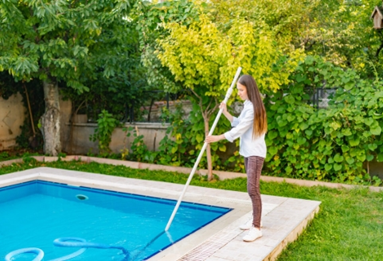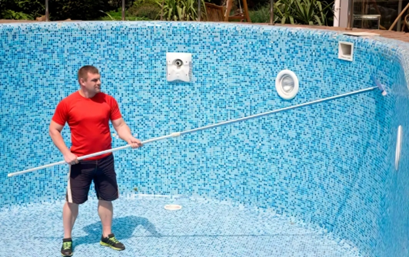A clean pool is not just visually appealing; it’s a vital part of keeping your swimming area safe and enjoyable. How to clean a pool may seem like a daunting task, but it doesn’t have to be. With the right tools, techniques, and maintenance routines, anyone can keep their pool sparkling clean. Whether you're a first-time pool owner or a seasoned pro, the advice in this guide will walk you through the essential steps to ensure your pool stays in excellent condition year-round. From skimming and scrubbing to balancing chemicals, we’ve got you covered with expert tips to make pool maintenance a breeze.
Why Regular Pool Cleaning Is Essential
Regular pool cleaning plays a pivotal role in ensuring the water remains healthy, safe, and crystal clear. Pool maintenance helps to prevent the buildup of bacteria, algae, and other contaminants, creating a hygienic environment for swimmers. Additionally, routine cleaning helps protect your pool equipment, such as the filter and pump, by preventing debris and dirt from clogging them. Neglecting regular maintenance can lead to costly repairs and water quality issues. It also reduces the need for excessive chemical treatments, ultimately saving you time and money. Regular cleaning boosts the overall aesthetic appeal of your pool, transforming it into a welcoming, relaxing retreat for family and guests.
The Essential Tools You Need to Clean Your Pool
Before diving into the cleaning process, it’s important to have the right tools on hand. Here’s a quick list:
• Pool Skimmer: Used to remove debris and leaves from the water’s surface.
• Pool Brushes: Vital for scrubbing walls, tiles, and other surfaces to prevent algae buildup.
• Pool Vacuum: Essential for cleaning the pool floor and removing settled dirt.
• Pool Chemicals: Necessary for maintaining water chemistry, including chlorine and pH balancers.
• Test Kits: Used to keep track of the water’s chemical levels and ensure they are balanced.
Step-by-Step Guide on How to Clean a Pool
Skimming the Pool Surface
Skimming the pool surface is the first and most important step in keeping your pool clean. Using a pool skimmer, remove floating debris such as leaves, insects, and twigs. This process should be done daily, especially during the fall when debris accumulates quickly. Skimming regularly prevents debris from sinking to the bottom, where it becomes more difficult to remove. Additionally, removing debris before it sinks helps maintain the cleanliness of the pool’s filtration system. Skimming should be done both before and after pool usage to ensure that the water remains clear and inviting for swimmers. This simple step goes a long way in keeping your pool pristine.

Scrubbing the Walls and Tiles
Regularly scrubbing your pool walls and tiles is crucial for preventing algae buildup, dirt, and stains. Use a pool brush with durable bristles to scrub the sides of the pool, focusing on areas with visible stains, slimy patches, or greenish algae. For tougher stains, you can use a specialized pool cleaner or a mixture of water and a small amount of pool bleach. Brush the walls at least twice a week, particularly in the warmer months when algae is more likely to grow. Scrubbing not only maintains the aesthetics of your pool but also helps improve water circulation by preventing debris from accumulating on surfaces, ensuring your pool stays clear.
Vacuuming the Pool Floor
Vacuuming the pool floor is an essential part of the pool cleaning process, ensuring that settled debris doesn’t disrupt the water quality. A pool vacuum helps remove dirt, leaves, sand, and other particles from the bottom of the pool. Whether you use a manual or automatic pool vacuum, always start from the shallow end and slowly work your way toward the deep end, ensuring even coverage. Manual vacuums may require more effort, while automatic models can be left to run for extended periods. Regular vacuuming prevents debris from clogging your filtration system and helps maintain the cleanliness and clarity of the pool water.
Testing and Balancing Pool Chemicals
Maintaining the proper chemical balance in your pool is essential for both the safety and comfort of swimmers. Use a pool test kit to regularly check the levels of chlorine, pH, and alkalinity in your pool water. Imbalanced chemicals can lead to cloudy water, skin irritation, or algae growth. Chlorine levels should be kept within the recommended range to kill bacteria and keep the water sanitary. The pH should be between 7.2 and 7.8, and alkalinity should be between 80 and 120 ppm. Regularly testing and adjusting the water chemistry, ideally, at least twice a week, helps maintain a healthy swimming environment and ensures long-term pool cleanliness.
How to Deal with Stubborn Pool Problems
Conclusion
Cleaning your pool is a straightforward but essential task that helps maintain a safe and inviting environment for swimmers. Knowing how to clean a pool is crucial to keeping it in top condition. By following a regular cleaning schedule, using the right tools, and balancing the pool’s chemicals, you can ensure that your pool stays sparkling and hygienic. Regular maintenance prevents the buildup of debris and harmful bacteria, prolongs the life of your pool, and reduces the need for expensive repairs. Keep your pool in excellent condition by staying on top of your cleaning routine, and enjoy a crystal-clear swimming experience all season long.
FAQ:
What chemicals are needed to clean a pool?
To keep your pool clean, you’ll need chlorine or bromine for sanitization, pH balancers like muriatic acid or soda ash, and alkalinity adjusters such as baking soda. Additionally, keep algaecides and flocculants on hand for specific issues.
How can I prevent algae growth in my pool?
Prevent algae growth by maintaining proper chlorine levels and balanced water chemistry. Regularly brush the pool surfaces and vacuum to remove debris. Use algaecide treatments as a preventative measure, especially during the hot summer months.
How do I know when my pool needs a deep cleaning?
A pool needs a deep cleaning if the water remains cloudy despite regular maintenance, if there’s noticeable algae buildup or staining, or if debris and dirt have accumulated at the bottom of the pool. Strong chlorine smells or irritated eyes and skin after swimming also signal a deep cleaning might be necessary.

